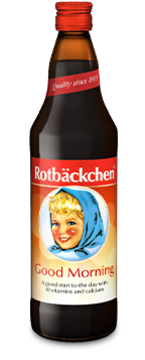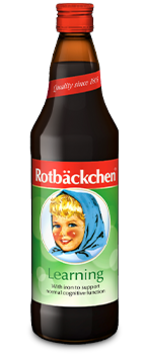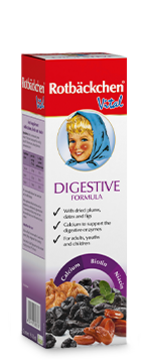Niacin
Niacin is better known as vitamin B3. It has many different functions but is particularly well known for maintaining healthy mucous membranes and skin. Since skin is our largest organ, an adequate supply of nutrients is particularly important for you and your children and should not be missing from a balanced diet.
What exactly is niacin?

Vitamins are extremely important for maintaining bodily functions. However, in most cases your body cannot produce them itself. But niacin is a bit different. Vitamin B3 generally belongs to the vitamin B complex, which the body can produce itself.
But what is niacin really? Vitamin B3 comes in two forms: nicotinic acid (vitamin B3) and nicotinamide, an amide of nicotinic acid that the body can convert into niacin. This B vitamin can also come from the amino acid “tryptophan”, which is found in many foods.
Niacin - Effects & tasks
![[Translate to Englisch:] Eltern bespaßen Kleinkind in der Küche [Translate to Englisch:] Eltern bespaßen Kleinkind in der Küche](https://www.rotbaeckchen.de/fileadmin/_processed_/a/b/csm_rotbaeckchen-niacin-01_b274ba3255.jpg)
The body mainly stores niacin in the liver. It supports normal nervous system and psychological functions, while helping to maintain normal skin and mucous membranes. Niacin also helps reduce tiredness and fatigue by supporting the energy metabolism.
Vitamin B3 daily requirement
![[Translate to Englisch:] Geerntete Kartoffeln [Translate to Englisch:] Geerntete Kartoffeln](https://www.rotbaeckchen.de/fileadmin/_processed_/d/c/csm_rotbaeckchen-niacin-02_5ad40ef0d3.jpg)
The daily requirement depends on age and gender. The German Society for Nutrition (DGE) gives the following reference values for niacin intake for children and adults:
| Age | Equivalent of niacin mg/day - Men | Equivalent of niacin mg/day - Women |
|---|---|---|
| Between 1 and 4 years | 8 mg | 8 mg |
| Between 4 and 7 years | 9 mg | 9 mg |
| Between 7 and 10 years | 11 mg | 10 mg |
| Between 10 and 13 years | 13 mg | 11 mg |
| Between 13 and 15 years | 15 mg | 13 mg |
| Between 15 and 19 years | 17 mg | 13 mg |
| Between 19 and 25 years | 16 mg | 13 mg |
| Between 25 and 51 years | 15 mg | 12 mg |
| Between 51 and 65 years | 15 mg | 11 mg |
| 65 and above | 14 mg | 11 mg |
| Pregnant women in 2nd trimester | 14 mg | |
| Pregnant women in 3rd trimester | 16 mg | |
| Breastfeeding women | 16 mg |
How to prevent niacin deficiency?
If you are careful about eating varied and healthy foods, both a deficiency and excess of niacin is unlikely. In fact, niacin deficiency is unlikely in general since your body can synthesise it itself. However, an unbalanced diet can promote niacin deficiency in otherwise healthy people.
Food with niacin
![[Translate to Englisch:] Kind betrachtet Kartoffeln in Supermarkt [Translate to Englisch:] Kind betrachtet Kartoffeln in Supermarkt](https://www.rotbaeckchen.de/fileadmin/_processed_/c/9/csm_rotbaeckchen-niacin-04_7dcc08d3b1.jpg)
Vitamin B3 can be produced independently by the body from the amino acid “tryptophane”. However, to cover you and your children’s daily requirements, you should also take vitamin B3 in your diet. People who eat a balanced diet and comparatively healthy lives can cover their daily requirements relatively easily.
Niacin is relatively resistant to heat for prolonged storage compared to other vitamins. However, it is water-soluble, which is why a certain proportion of it passes from foods into water during cooking, e.g. with vegetables. Many foods contain niacin; however, your body can process vitamin B3 from animal food much better than from plants. Furthermore, the niacin content of animal products is usually higher.
| Food | Niacin per 100 g |
|---|---|
| Chicken liver | 12 mg |
| Oyster mushroom | 10 mg |
| Tuna | 8,5 mg |
| Beef (pure muscle meat) | 7,5 mg |
| Cultivated mushrooms | 5,2 mg |
| Saithe | 4 mg |
| Lentils | 2,5 mg |
Average values according to Souci, Fachmann, Kraut: Food Composition and Nutrition Tables (7th ed.). Munich: C.H. Beck. 2008
More about vitamins & nutrients

Vitamins & minerals
Want to know what all the valuable micronutrients do, what foods have them and how much you need? Find more information here.

B vitamins
The different members of the vitamin B complex perform different tasks – they take care of energy balance, the nervous system and many other processes in the body.
Find out more
Biotin
The many different members of the vitamin B complex with their different properties play an important role for your energy balance, the nervous system and other components of a healthy organism.
Find out more


